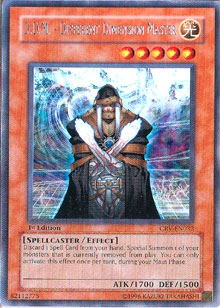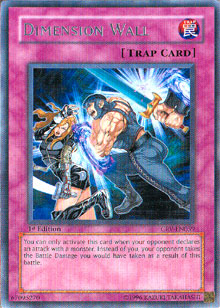No one has yet determined why the travelers emerged from the different dimension. They arrived in the world of Yu-Gi-Oh! with powers over the removed zone that most monsters had never encountered. Soon after the monsters appeared, spells and traps followed with further powers that involved the removed zone.
Cybernetic Revolution brings new powers from the different dimension. True to form, two of the new Different Dimension cards involve the removed zone, but the trap card Dimension Wall brings a new defensive power from the different dimension.
This week we’ll examine the effects of the newest Different Dimension cards and handle some common rules problems that you may encounter when you play with these cards.
“Discard 1 Spell Card from your hand. Special Summon 1 of your monsters that is currently removed from play. You can only activate this effect once per turn, during your Main Phase.”
 When you activate the effect of D.D.M. – Different Dimension Master, you’ll begin by discarding a spell card from your hand. Then, you’ll choose a face-up monster in your removed zone as a target. Your opponent is then given the chance to respond.
When you activate the effect of D.D.M. – Different Dimension Master, you’ll begin by discarding a spell card from your hand. Then, you’ll choose a face-up monster in your removed zone as a target. Your opponent is then given the chance to respond.
Your selection is limited to monsters that you can legally special summon. Monsters with special summon requirements that were removed from play without ever satisfying those requirements will be off limits. If you use Metamorphosis or Cyber-Stein to special summon a fusion monster into play, and if that monster is later removed from play, you wouldn’t be able to special summon it with D.D.M. – Different Dimension Master’s effect. This is because fusion monsters are only properly summoned by fusion summons, so their summoning requirements were not satisfied. For this reason, they are off limits to the effect of D.D.M. – Different Dimension Master.
Monsters like Ancient Gear Golem and Ancient Gear Beast are always off limits to D.D.M. – Different Dimension Master, because their effects state that they cannot be special summoned. Monsters like Armed Dragon LV7 and Horus the Black Flame Dragon LV8 cannot be special summoned unless you follow the method described on the card, so they are also off limits to D.D.M. – Different Dimension Master’s effect.
Some monsters that would normally have special summon restrictions are perfectly fine to bring back with the Different Dimension Master. Dark Ruler Ha Des’s text says that it cannot be special summoned from the graveyard, but Different Dimension Master’s effect does not special summon Dark Ruler Ha Des from the graveyard. Dark Ruler Ha Des is a perfectly fine choice.
As a final note, there’s a way to use the effect of D.D.M. – Different Dimension Master more than once during the same turn, but it requires some planning. It’s only possible if you can manage to turn D.D.M. – Different Dimension Master face down after using its effect and then flip it face up, or if you remove it from the field and then return it to the field again. For example, if you were to use Different Dimension Master’s effect in your first main phase and then flip it face down with Book of Moon, you could flip it face up with a card like Book of Taiyou and then use its effect again.
D. D. Trap Hole
“You can only activate this card when your opponent Sets 1 monster in Defense Position. Destroy and remove from play the Set monster and 1 monster on your side of the field.”
 The word “sets” in the first sentence is a verb that refers to the act of physically placing a monster face down onto the field. This can be accomplished either by a player placing a monster from his or her hand on the field in face down defense position, or through card effects that special summon a monster onto the field in face down defense position, like that of The Shallow Grave. The verb form of “set” even includes the act of turning a face-up monster face down with a card effect, but this is usually done through the use of cards like Tsukuyomi or Book of Moon.
The word “sets” in the first sentence is a verb that refers to the act of physically placing a monster face down onto the field. This can be accomplished either by a player placing a monster from his or her hand on the field in face down defense position, or through card effects that special summon a monster onto the field in face down defense position, like that of The Shallow Grave. The verb form of “set” even includes the act of turning a face-up monster face down with a card effect, but this is usually done through the use of cards like Tsukuyomi or Book of Moon.
D. D. Trap Hole cannot be activated when a player sets multiple monsters at the same time. Setting multiple monsters at the same time is normally accomplished through card effects, like that of Cyber Jar. But if your opponent only sets one monster from Cyber Jar’s effect, it would be fine to use D. D. Trap Hole. For example, if your opponent picked up three monsters from the effect of Cyber Jar and chose to summon two and set one, you would be able to use D. D. Trap Hole. This is because your opponent has only set one monster.
However, you can’t use D. D. Trap Hole in the damage step, so keep that in mind when you destroy your opponent’s Apprentice Magician.
Now that your opponent has set his or her monster, you can spring the trap into action. When you activate it, you must select one monster on your side of the field and the monster that your opponent has set. These monsters will be the targets of the effect. When the effect resolves, both targeted monsters are destroyed and removed from play.
The selection of targets can lead to more problems. If one of the targets is removed from the field or from play before the effect resolves, the effect of D. D. Trap Hole will disappear and fail to remove either monster from play.
Notice in the second sentence that the opponent’s monster is referred to as “the Set monster.” In this context, “set” is used as an adjective to describe the monster’s condition. If the opponent’s monster is flipped face up before D. D. Trap Hole resolves, the monster will no longer be “set” and thus will no longer be a legal target. This will also cause the effect of D. D. Trap Hole to disappear.
Example:
Your opponent sets one monster during his main phase. You respond by activating D. D. Trap Hole, targeting a monster you control and the monster your opponent just set. Your opponent responds by activating Desert Sunlight.
When the chain resolves, Desert Sunlight will flip the opponent’s set monster face up. D. D. Trap Hole attempts to resolve—but its effect fails, because the opponent’s monster is no longer “set.”
 “You can only activate this card when your opponent declares an attack with a monster. Instead of you, your opponent takes the Battle Damage you would have taken as a result of this battle.”
“You can only activate this card when your opponent declares an attack with a monster. Instead of you, your opponent takes the Battle Damage you would have taken as a result of this battle.”
The first thing to remember about Dimension Wall is that it won’t stop the attack. In fact, that would completely defeat the purpose of the card. Dimension Wall is used to make your opponent receive the damage that you would normally have taken from his or her monster’s attack. You will determine the amount of damage when you determine damage calculation during the damage step. If your opponent is attacking one of your monsters and you activate this card, your monster can still be destroyed by the battle.
Example:
Jaden uses Elemental Hero Flame Wingman to attack Syrus’s attack position Jetroid. Syrus responds to the attack by activating Dimension Wall.
The attack proceeds to the damage step. Jaden and Syrus calculate the damage from the attack and determine that Syrus should receive 900 points of damage. (2100 minus 1200 equals 900.) However, because Syrus used Dimension Wall, Jaden will receive this damage instead.
What about the effect damage from Elemental Hero Flame Wingman? The 1200 points of damage that Syrus will receive from its effect is not redirected at Jaden, because it is damage from a card’s effect and not battle damage.
Suppose the opponent’s monster has an effect that activates when it inflicts battle damage to your life points. If you use Dimension Wall, that monster’s effect will not activate because the battle damage will be redirected. This also means that the monster will not turn on its master. If your opponent attacks you with Don Zaloog, using Dimension Wall will not cause the opponent to have to discard a card or lose two cards from the top of his or her deck.
Send all comments to Curtis@metagame.com